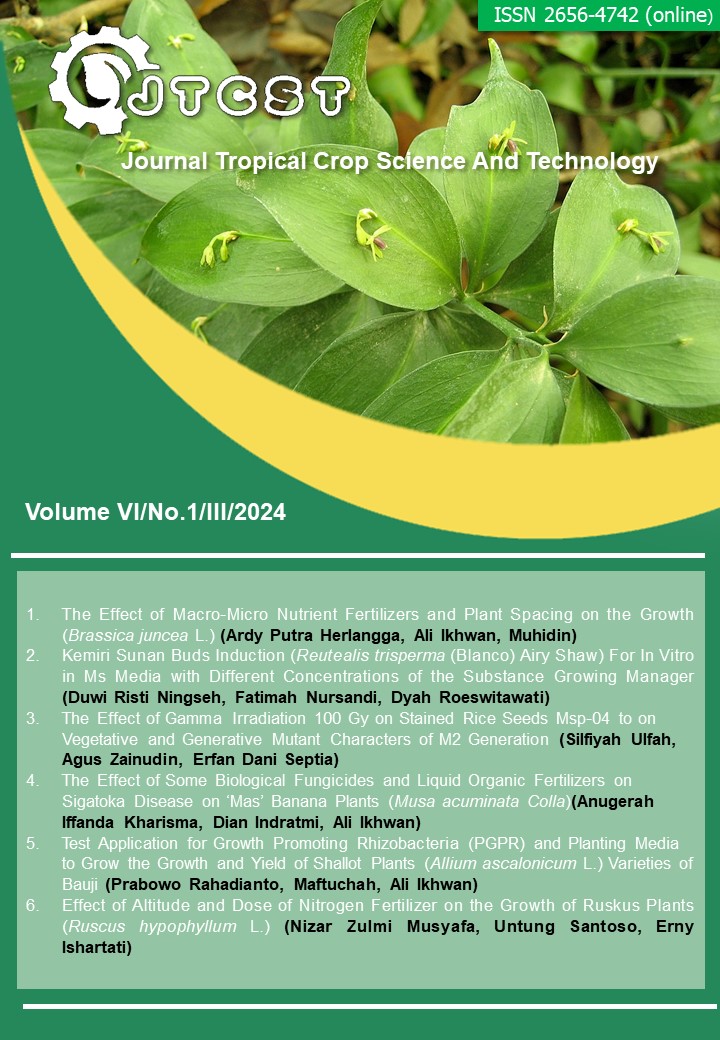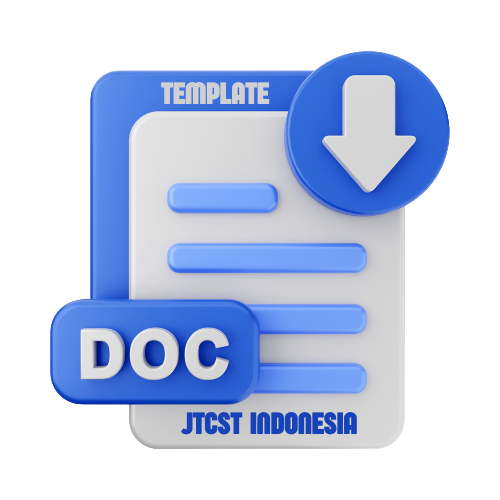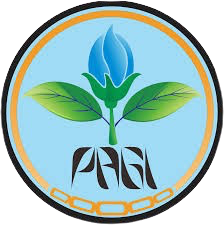The Effect of Gamma Irradiation 100 Gy on Stained Rice Seeds Msp-04 to on Vegetative and Generative Mutant Characters of M2 Generation
DOI:
https://doi.org/10.22219/jtcst.v6i2.35600Keywords:
Character, M2, Mutant, RiceAbstract
This study aims to obtain information on changes in the character of individual M2 generation mutant rice, similarities between individuals of the M2 generation mutant and its comparison, and correlation between variables. This research was conducted by observing the vegetative, generative, and potential yields of each individual rice mutant and its comparison. The data obtained were tested by cluster analysis and correlation analysis. The observations showed that almost all the characters of the M2 generation mutant individuals changed except for the qualitative vegetative characters. Cluster analysis based on quantitative vegetative character showed 1 different mutant individual (0% similarity), and 1 other individual with 38.83% similarity compared to other and non-mutant mutants, and commercial varieties. Based on quantitative and production generative characters, there are 2 distinct groups that differ from each other (0% similarity). The similarity range of each distinct group is 21.17-43.56%. The strong to very strong and very significant correlation that occurs in vegetative and generative characters with production is found between the number of tillers and panicles, total grain weight and dry grain weight of 98.7% each; 60.9% and 58.3%; the number of leaves is thus also between the number of panicles, total grain weight and dry grain weight respectively 91.3%; 53.3% and 53.4%; panicles with total grain weight and dry grain weight were 60.1% and 57.6%, respectively.
Downloads
References
Abdullah, B., S. Tjokrowidjojo, dan Sularjo. 2008. Perkembangan dan Prospek Perakitan Padi Tipe Baru di Indonesia. Jurnal Litbang Pertanian, 27 (10) : 1-9.
Badan Pusat Statistik. 2015. Konsumsi Rata-Rata per Kapita Seminggu Beberapa Macam Bahan Makanan Penting. https://www.bps.go.id/linkTabelStatis/view/id/950. (diakses pada tanggal 3, September, 2019).
BPTP Sumatra Barat, (2012). Identifikasi Varietas Lokal dan Uji Adaptasi Galur Harapan Padi Sawah Prefensi Konsumen Sumatra Barat.
Budiarti, SG. Rizki, YR, dan Kusumo, YWE, 2004. Analisis Koefisien Lintas Beberapa Sifat Pada Plasma Nutfah Gandum (Triticum aestivum L.) Koleksi Balitbiogen. Zuriat 15 (1) : 3140.
Danu, S. 2018. Pengembangan Galur Padi Unggul MSP. Hasil Wawancara Pribadi: 27 Maret 2018. Lampung Tengah.
Dewi, I.S., E.G. Lestari, Chaerani dan R. Yunita. 2015. Penampilan Galur Mutan Dihaploid Padi Tipe Baru di Sulawesi Selatan. Jurnal Agonomi Indonesia, 43 (2) : 89-98.
Faozi, K., dan Bambang. 2010. Tanggap Tanaman Padi Sawah dari Berbagai Umur Bibit Terhadap Pemupukan Nitrogen. J. Agonomika. 1 (10) : 32-42.
Hadi Prajogo U dan Budi Wiryono (2005). Dampak Kebijakan Proteksi Terhadap Ekonomi Beras Di Indonesia. Jurnal Ago Ekonomi, 23(2), 159–175.
Herawati, R., Purwoko, B. S., & Dewi, I. S. (2009). Keragaman genetik dan karakter agonomi galur haploid ganda padi gogo dengan sifat-sifat tipe baru hasil kultur antera. Jurnal Agonomi Indonesia (Indonesian Journal of Agonomy), 37(2).
IRRI. (2002). http://cybex.pertanian.go.id/mbile/artikel/58992/fase pertumbuhan-padi-dan kebutuhan-pupuk-berimbang setiap-fase-pertumbuhannya/. (diaksespada tanggal 27 september 2019).
Kartina, N. (2017). Korelasi Hasil dan Komponen Hasil Padi Hibrida di Dua Lokasi Pengujian. Jurnal Penelitian Pertanian Tanaman Pangan, 1(1), 11-19.
Kholis, N. (2019). Karakterisasi Generasi M-1 Padi (Oryza sativa L.) MSP-04 dan MSP-13 Hasil Radiasi Sinar Gamma 100 Gy. Skripsi. Universitas Muhammadiyah Malang.
Mahmud, Y., dan S.S. Purnomo. 2014. Keragaman Agonomis beberapa Varietas Unggul baru Tanaman Padi (Oryza sativa L.) pada Model pengelolaan Tanaman Terpadu. Jurnal Ilmiah Solusi, 1 (1) : 1-10.
Makarim, K. dan E. Suhartatik. 2009. Morfologi dan Fisiologi Tanaman Padi. Balai Besar Penelitian Tanaman Padi. p. 296-326.
Makarim, K. dan E. Suhartatik. 2009. Morfologi dan Fisiologi Tanaman Padi. Balai Besar Penelitian Tanaman Padi. p. 296-326.
Meliala, J. H. S., Basuki, N., & Soegianto, A. (2016). Pengaruh iradiasi sinar gamma terhadap perubahan fenotipik tanaman padi gogo (Oryza sativa L.). Jurnal Produksi Tanaman, 4(7).
Mugiono, L. Harsanti, A.K. Dewi. (2009). Perbaikan padi varietas Cisantana dengan mutasi induksi. Jurnal Ilmiah Aplikasi Isotop dan Radiasi, 5 (2), 194-210.
Mulyaningsih, E. S., Perdani, A. Y., Indrayani, S., & Suwarno, S. (2016). Seleksi Fenotipe Populasi Padi Gogo untuk Hasil Tinggi, Toleran Alumunium dan Tahan Blas di Tanah Masam. Jurnal Penelitian Pertanian Tanaman Pangan, 35(3), 191-197.
Pheng, S., G.S. Khush, P. Virk, Q. Tang, Y. Zou. 2008. Progess in Ideotype Breeding to Increase Rice Yield Potential. Field Crop Research 108(3).
Pratama, Sanda Aditya & Saptadi Dermawan. (2019). Potensi Hasil Galur-Galur Harapan Padi Sawah. Jurnal Produksi Tanaman, 6(7).
Puspitasari, N., Indrawati, L. R., Sarfiah, S. N., Ekonomi, F., & Tidar, U (2017). Analisis Pengaruh Harga Beras, Cadangan Devisa, Dan Rata-Rata Konsumsi Beras per Kapita Seminggu Terhadap Impor Beras Di Indonesia Tahun 2008- 2017. 1, 55–67.
Putra, S., I. Suliansyah dan Ardi. 2010. Eksplorasi dan Karakterisasi Plasma Nutfah Padi Beras Merah di Kabupaten Solok dan Kabupaten Solok Selatan Provinsi Sumatera Barat. Jurnal Jerami, 3 (3) : 139-157.
Riyanto, A., Widiatmoko, T., & Hartanto, B. (2012). Korelasi antar komponen hasil dan hasil pada padi genotip F5 keturunan persilangan G39 X Ciherang. Prosiding, 3(1).
Salsinha, Y, C, F. 2015. Pengaruh Irradiasi Sinar Gamma Co-60 Terhadap Pertumbuhan Padi (Oryza Sativa) Situ Bagendit Pada Cekaman Kekeringan. Fakultas Biologi Gadjah Mada .Sleman Yogyakarta.
Simarmata, M. 2010. Deskripsi Morfologi Kultivar Padi Gogo di Bengkulu. Jurnal Akta Agosia Vol. 13 No.1 Hal. 8-15.
Sobrizal, D (2017). Potensi Pemuliaan Mutasi untuk Perbaikan Varietas Padi Lokal Indonesia. Jurnal Ilmiah Aplikasi Isotop Dan Radiasi, 12(1), 23. https://doi.org/10.17146/jair.2016.12.1.3198
Sobrizal. A., dan Ismachin, M. (2006) significant contribution of mutation techniques to rice breeding in Indonesia. Plant Mutation Reports, 1 (1), 18-21.
Supriyanti, A., Supriyanta, S., & Kristamtini, K. (2015). Karakterisasi Dua Puluh Padi (Oryza sativa. L.) Lokal Di Daerah Istimewa Yogyakarta. Vegetalika, 4(3), 29-41.
Tri, R (2019). Keragaman Genetik Padi Hitam (Oryza sativa L . ) Populasi M2 Hasil Mutasi Kolkisin Genetic Diversity of M2 Population of Black Rice (Oryza sativa L.) Derived from Colchicine Mutation. 7(2), 291–297.
Widayah, Y. (2007). Keragaman morfologi beberapa familia zingiberaceae (zingiber, curcuma, dan kaempferia) di Beberapa Wilayah Jawa Tengah.
Wiratna, S. (2014). SPSS untuk Penelitian. Jakarta: Penerbit Baru.
Downloads
Published
How to Cite
Issue
Section
License
Copyright (c) 2024 Silfiyah Ulfah

This work is licensed under a Creative Commons Attribution-ShareAlike 4.0 International License.
Authors who publish with this journal agree to the following terms:
- Authors retain copyright and grant the journal right of first publication with the work simultaneously licensed under a Creative Commons Attribution License that allows others to share the work with an acknowledgement of the work's authorship and initial publication in this journal.
- Authors are able to enter into separate, additional contractual arrangements for the non-exclusive distribution of the journal's published version of the work (e.g., post it to an institutional repository or publish it in a book), with an acknowledgement of its initial publication in this journal.
- Authors are permitted and encouraged to post their work online (e.g., in institutional repositories or on their website) prior to and during the submission process, as it can lead to productive exchanges, as well as earlier and greater citation of published work (See The Effect of Open Access).











